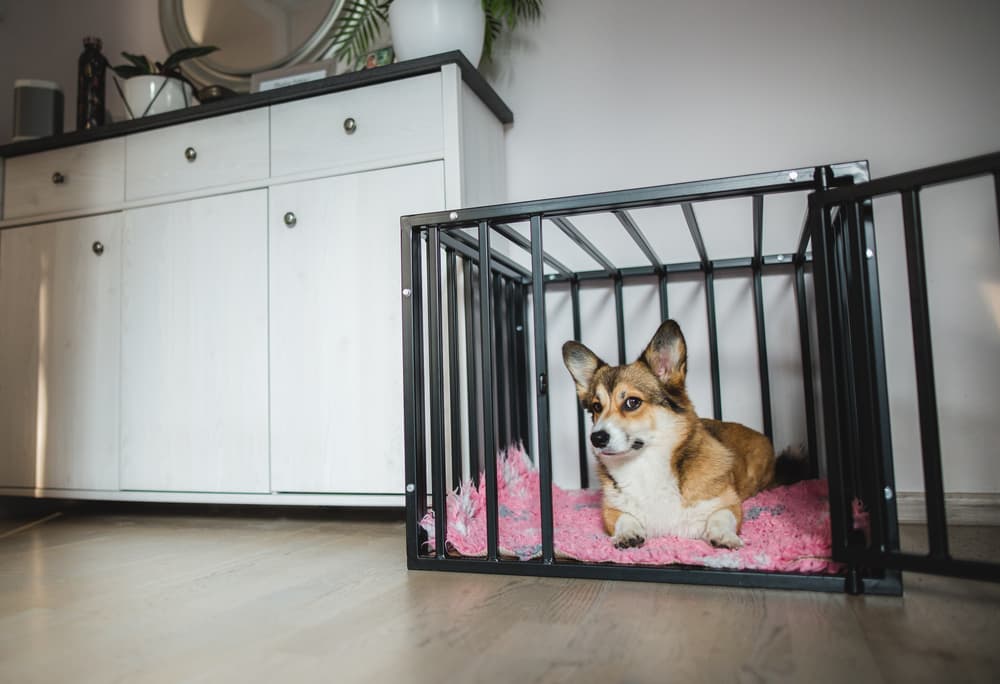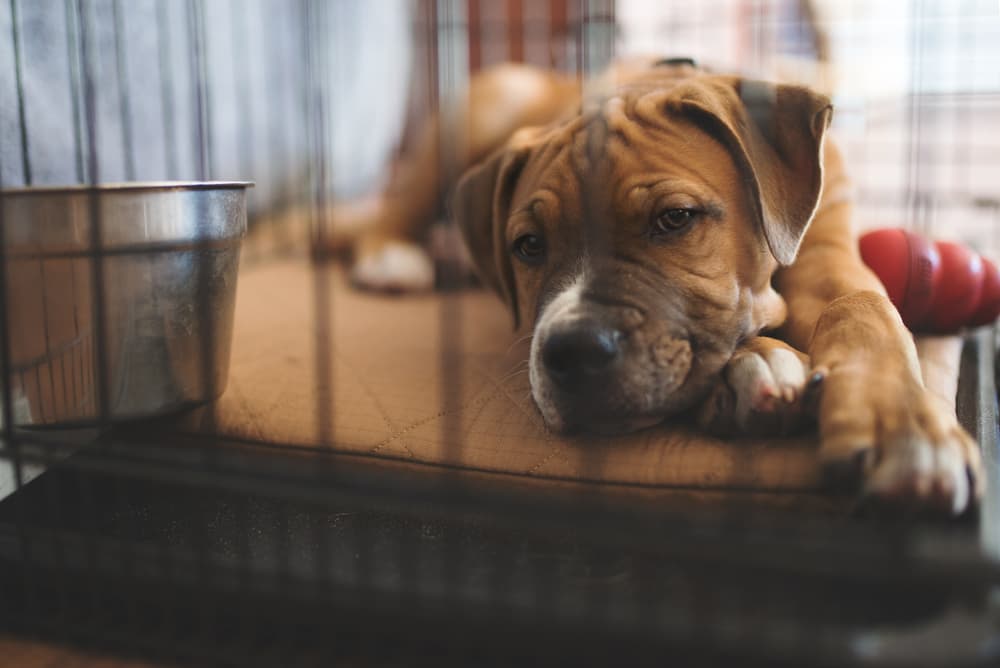Where Is the Best Place for a Puppy’s Crate?

You’ve gotten a puppy and have most likely done tons of homework, making you well aware of how important crate training is for the health and safety of your new best friend.
It’s crucial to create a special “zen zone” where your pup can relax when you’re not around to supervise. But you might be wondering: where is the best place for a puppy’s crate?
It may come as a surprise that there’s no one perfect spot for a puppy crate. In fact, there are probably several options within your home that will work for both you and your pup. That said, there are also some no-go regions where you should avoid putting your puppy’s crate. The following tips will help you get started on picking the perfect crate space for your puppy.
Factors to Consider Placing Your Puppy’s Crate
Your puppy needs to be crated for a number of reasons, including:
- Safety: A puppy crate keeps your dog from chewing inappropriate items like your shoes, the TV remote, electrical wires, furniture, and the garbage can when you’re not available to supervise.
- Potty Training: Using a crate encourages pups to refrain from eliminating since most dogs won’t soil where they sleep. This is considered a primary reason for crate training a puppy.
- Relaxation: Many pups like to take a break in a quiet spot away from the hubbub of the house.
Keeping all of this in mind will help you determine the best spot, or more likely, spots, for your puppy’s crate.
For example, the safety aspect means you should keep the crate away from items that could become accidental chewing targets and be pulled into the crate, like curtains or wires. And when it comes to potty training, speed is everything, so the crate should be kept in a location that’s a quick jog to a door. A big part of crate time is helping your puppy learn to relax inside, so you’ll want to pick a location that’s quiet enough to allow for napping, but not a completely isolated area like the basement or garage.
Puppy Crate Location During Training
Every puppy needs an acclimation period to adjust to being in the crate, and it’s helpful to keep the crate in a central location during that training phase. This training process involves brief periods of your puppy hanging out in the crate with you nearby, and then as you progress, with you out of the room. Keeping the crate in a central location during training, like the kitchen or family room, will help your pup learn to accept and appreciate being in there.
Once your puppy is content in the crate, you can move it to a spot in the house that’s close to the daily goings on but quiet enough to encourage lots of puppy naps.
Bedtime presents a new challenge because before you can celebrate your young puppy sleeping through the night, they’ll most likely need to go outside for a midnight (or later) potty break. This means that you need to be able to hear your pup upon waking. Pet parents can either keep the crate in the bedroom so they’re able to hear when their puppy starts signaling, or in a nearby room that’s still close enough to listen for the “I gotta go” whines. A baby monitor set up near the crate can help bridge the gap if necessary.
Where is the Best Place for a Puppy’s Crate?

The best place for your puppy’s crate will depend on your preferences, your house setup, and your puppy. Every household is different, so while a single perfect crate location doesn’t exist, there are some pros and cons to consider with each option.
Here are some of the most ideal places for a puppy’s crate and some considerations to keep in mind.
Bedroom
With a young puppy, having the crate in your bedroom can make potty training easier and help you avoid messes in the crate. Bedrooms also tend to be quiet, relaxing spaces that allow for dog downtime.
Pros
- You’re close enough to hear when your puppy needs to go out for a potty break
- Bedrooms are quiet and relaxing spaces
Cons
- Light sleepers (canine and human) might not appreciate their companion’s night sounds
Living Room/Family Room
If you want to keep your puppy close by during the day, the living room or family room is a natural place to keep your puppy’s crate. There are even some dog crate furniture options that double as living room furniture!
Pros
- It’s a central location in the house so the puppy isn’t isolated
- You’ll be able to spend time with your puppy while crate training
Cons
- Some living rooms might be too busy and make it difficult for a dog to relax
- If your living room is far from your bedroom, it might be tough to hear your puppy at night
Kitchen
This kitchen is the heart of the home and is often an ideal choice for your puppy’s crate location. Kitchens often have quick access to the outdoors for potty breaks and cleaning in a kitchen tends to be easier than other rooms in the home.
Pros
- The puppy remains a part of daily life
- Many kitchens have quick access to the outdoors
- Kitchens tend to have durable flooring, making cleaning easier
Cons
- There might be too much noise and activity for the puppy to adequately settle
- If your kitchen is removed from your bedroom, hearing a puppy at night could be tough
Finished Basement
A finished, downstairs basement can be a good place for your puppy’s crate if you spend time down there as a family. Finished basements are often durable and this placement allows you to keep the crate out of sight in your main living areas. However, it’s not a good idea to put a crate in the basement if it’s an area of the house that is rarely used. And we never recommend placing a puppy’s crate in an unfinished basement.
Pros
- It’s quiet
- It keeps your puppy’s crate from messing with your home’s decor
Cons
- It might be too isolated from the rest of the house
Tips for Choosing the Best Place for a Puppy’s Crate
From the floor plan of the house itself to the way family members utilize the space (one person’s isolated basement could be another family’s hangout spot), every house has its own unique quirks.
And don’t forget – every puppy has their own unique quirks, too, which means where you put your puppy’s crate ultimately comes down to what works best for everyone. When selecting a location for your puppy’s crate, consider using the following checklist:
- It’s a relatively peaceful place
- The temperature is comfortable and consistent
- There’s easy access to the outside
- You can hear when your puppy tells you it’s time for nighttime potty trips
- There’s nothing nearby that your puppy can access, like cords or curtains
- It’s not near anything potentially stressful, like construction noise outside, a loud washing machine, or a busy hallway
Troubleshooting the Location of Your Puppy’s Crate

Can I move the crate to different locations?
It’s perfectly fine to move your puppy’s crate around your home. In fact, the crate can function as your puppy’s familiar “home away from home” when you travel to new places.
Is it okay to use multiple crates?
Yes! Having multiple crates can be especially helpful if you have a bigger puppy, since it’s challenging to be constantly moving an oversized crate. Keeping a primary crate in one spot and a secondary in your bedroom prevents having to haul a large crate around.
What if my puppy whines at night?
A little bit of puppy commentary in the crate is normal during the settling-in process, but a middle-of-the-night whine usually equals a potty break (which is why you need to keep the crate close enough that you can hear when your puppy cries). After the potty trip, make sure to gently place your pup back in the crate for the rest of the night.
Puppy Crate Location: Final Thoughts
Finding the perfect location for crate training puppies is all about choosing a space that helps your dog feel comfortable and safe, and is also convenient for you at the same time. It may take a little trial and error, but in time, you and your new best friend will find a mutually agreeable crate zone that makes puppy crate training a breeze.









